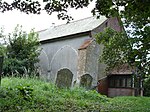Wrabness Nature Reserve
Essex Wildlife TrustLocal Nature Reserves in Essex

Wrabness Nature Reserve is a 27 hectare Local Nature Reserve on the south bank of the River Stour, west of Wrabness in Essex. It is managed by the Essex Wildlife Trust.This site has grassland, marsh, scrub and woodland. It has a diverse bird life, such as yellowhammers, whitethroats, song thrushes and short-eared owls. There are also winter visitors including black-tailed godwits, grey plovers and turnstones. Plants include corn mints and hairy buttercups, and there is a wide variety of invertebrates. The grassland is grazed to prevent the vegetation from becoming too coarse.There is access from Whitesheaf Lane.
Excerpt from the Wikipedia article Wrabness Nature Reserve (License: CC BY-SA 3.0, Authors, Images).Wrabness Nature Reserve
Wheatsheaf Close, Essex
Geographical coordinates (GPS) Address External links Nearby Places Show on map
Geographical coordinates (GPS)
| Latitude | Longitude |
|---|---|
| N 51.9409 ° | E 1.14257 ° |
Address
Wrabness Nature Reserve
Wheatsheaf Close
CO11 2TD Essex
England, United Kingdom
Open on Google Maps







